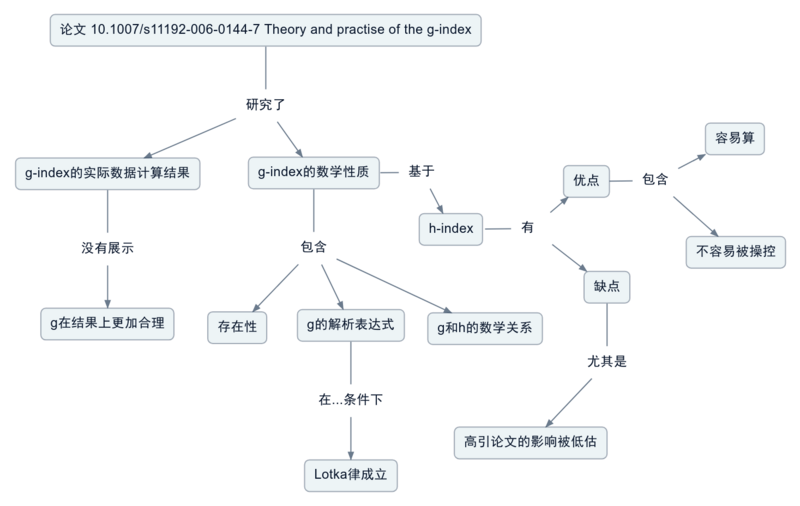分类:Theory and practise of the g-index
Egghe, L. Theory and practise of the g-index. Scientometrics 69, 131–152 (2006). https://doi.org/10.1007/s11192-006-0144-7
English version
Summary and comments
What are the research questions?
- What is the advantage of the g-index over the h-index, theoretically and practically, although the same question has been investigated in [1] and [2] by the same author.
- Mathematical properties of the g-index: its existence, relation between g and h,mathematical expression of g under the Lotka law.
How the research are done(method and procedure)?
- Review the development of the h-index, comment on its advantages and disadvantages
- Propose the g-index to hopefully keep the advantage while getting rid of the disadvantage of the h-index
- Study the mathematical properties of the g-index: its existence, relation between g and h,mathematical expression of g under the Lotka law.
- Comparing empirical results on g and h
Methods: Mathematical reasoning including mathematical derivation and proof, and applying the indexes on empirical data via programming.
Why it is done in this way?
The author, Egghe, is a researcher in scientometrics with a strong mathematical background. Thus, it is natural form him to consider the relation between the previously proposed index and the actual problem or intention, and also to rely on mathematical derivation and proof to present the main results, and further more to apply the indexes to empirical data.
Generally speaking, most researchers in applied math, in its broad sense, including physics and all natural and social sciences, should be able to do the above: comparing the definition and its actual intention/problem, using mathematical derivation and proof, empirical analysis often via programming.
What are the results
- The existence of the g-index.
- [math]\displaystyle{ g\geq h }[/math].
- The expression of g under the Lotka law: [math]\displaystyle{ g=\left(\frac{\alpha-1}{\alpha-2}\right)^{\frac{\alpha-1}{\alpha}} h }[/math].
- On empirical data, g and h are different.
What are the conclusions
Intuitively, the g-index does seem to keep the advantage while getting rid of some of the disadvantage of the h-index, and it can be calculated on empirical data and the results are different from the h-index to a certain degree. Thus, proposing of the g-index is justified to some degree.
What is the implication/meaning of the research question, method and conclusion to the discipline?
- It does seem to be a further development of the h-index.
- Concern: However, the empirical results only show that the two indexes are different, but not clear on which one is better in the sense of answering the actual/intended problem.
Meaningful to me?
In mathematical modeling a scientific problem, it is common to start from a previously defined quantity and consider its advantage and disadvantage, to propose a new definition and study its mathematical properties, and then to compare the old and new quantities on empirical data.
BY the way, on this topic of measuring scientific impact of research papers and authors, [3] is a quite reasonable review.
Concept Map
h-index, number of received citation, ranking order, g-index, existence, Lotkaian law, empirical results

- ↑ EGGHE, L. (2006a), An improvement of the h-index: The g-index. ISSI Newsletter, 2 (1) : 8–9.
- ↑ EGGHE, L. (2006c), How to improve the h-index: Letter. The Scientist, 20 (3) : 14, March 2006.
- ↑ Waltman, Ludo. “A review of the literature on citation impact indicators.” J. Informetrics 10 (2015): 365-391.
中文版
Egghe, L. Theory and practise of the g-index. Scientometrics 69, 131–152 (2006). https://doi.org/10.1007/s11192-006-0144-7
文章总结和评论
研究了什么问题
- g-index相比拓展之前的h-index 有什么好处。从理论上和实际结果两个角度。其实这问题在他自己之前的文章中[1][2]已经提到。
- g的数学性质:存在性、g和h的关系,g在Lotka律成立的条件下的形式
怎么来研究的(研究方法和思路流程)
- 先回顾了h的历史,点出好处和缺陷
- 提出保留h的好处,弥补缺陷的新的g
- 研究g的数学性质:存在性、g和h的关系,g在Lotka律成立的条件下的形式
- 在实际数据上算出来新旧指标的结果,做个对比
具体分析方法有:数学计算推导、演绎证明、实际数据分析。
为什么这样研究
Egghe是一个数学背景的科学学研究者。因此,他会从科学的角度来考虑前人的指标和实际问题之间的关系,会用数学证明和数学计算来分析问题,还会用实际数据上的计算分析。
得到了什么结果
- g存在。
- [math]\displaystyle{ g\geq h }[/math]。
- g在Lotka律成立的条件下的形式:[math]\displaystyle{ g=\left(\frac{\alpha-1}{\alpha-2}\right)^{\frac{\alpha-1}{\alpha}} h }[/math]。
- 在实际数据上,g和h确实不一样。
得到了什么结论
从直觉上,确实g弥补了h的一些缺陷,也确实存在可以算出来,值得提出
问题方法结论对学科的意义
- 保留了h的精神,进一步发展了h,看起来似乎弥补了一些缺陷。
- 问题:但是,实际上,从数值结果上,没有展示是不是真的g更有道理。如果这个能够进一步展示,就更好了。否则,觉得更好不一定真的就能更好。
对我自己的意义
从一个已有的量——通过对比这个量和这个量描述的实际对象——的缺陷开始,提出一个修正性的新的量,然后研究其数学性质、对比新旧两个量,最后用实际数据算出来结果对比一下,是一个非常典型的数学建模和科学研究的思路。
另外,[3]对论文和作者的影响力的各种指标作了一个很好的综述。
概念地图
h-index, number of received citation, ranking order, g-index, existence, Lotkaian law, empirical results

本文所引的和其他的重要参考文献
- ↑ EGGHE, L. (2006a), An improvement of the h-index: The g-index. ISSI Newsletter, 2 (1) : 8–9.
- ↑ EGGHE, L. (2006c), How to improve the h-index: Letter. The Scientist, 20 (3) : 14, March 2006.
- ↑ Waltman, Ludo. “A review of the literature on citation impact indicators.” J. Informetrics 10 (2015): 365-391.
本分类目前不含有任何页面或媒体文件。